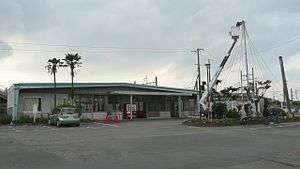Yamanokuchi Station
Yamanokuchi Station (山之口駅, Yamanokuchi-eki) is a railway station in Miyakonojō, Miyazaki, Japan. It is operated by of JR Kyushu and is on the Nippō Main Line.[1][2]
Yamanokuchi Station 山之口駅 | |
|---|---|
 Yamanokuchi Station in 2008 | |
| Location | Japan |
| Coordinates | 31°46′58″N 131°09′11″E |
| Operated by | |
| Line(s) | ■ Nippō Main Line |
| Distance | 379.1 km from Kokura |
| Platforms | 1 island platform |
| Tracks | 2 |
| Construction | |
| Structure type | At grade |
| Disabled access | No - platform accessed by footbridge |
| Other information | |
| Status | Unstaffed |
| Website | Official website |
| History | |
| Opened | 15 August 1914 |
| Traffic | |
| Passengers (FY2016) | 194 daily |
| Location | |
 Yamanokuchi Station Location within Japan | |
Lines
The station is served by the Nippō Main Line and is located 379.1 km from the starting point of the line at Kokura.[3]
Layout
The station, which is unstaffed, consists of an island platform serving two tracks. The station building is a modern steel frame structure which houses a waiting area and an automatic ticket vending machine. Access to the island platform is by means of a footbridge.[2][3]
History
Japanese Government Railways (JGR) had opened the Miyazaki Line from Yoshimatsu to Miyakonojō on 8 October 1913. The track was extended east in phases, with Yamanokuchi opening as the new terminus on 15 August 1914. It became a through-station on 21 March 1916 when the track was extended to Aoidake. By 21 September 1917, the track had reached Miyazaki and line was renamed the Miyazaki Main Line. By 1923, the track had reached north to link up with the track of the Nippō Main Line at Shigeoka. On 15 December 1923, Yamanokuchi was designated as part of the Nippō Main Line together with the entire stretch through Miyazaki to Yoshimatsu. With the privatization of Japanese National Railways (JNR), the successor of JGR, on 1 April 1987, the station came under the control of JR Kyushu.[4][5]
Passenger statistics
In fiscal 2016, the station was used by an average of 194 passengers (boarding only) per day.[6]
See also
References
- "JR Kyushu Route Map" (PDF). JR Kyushu. Retrieved 23 February 2018.
- "山之口" [Yamanokuchi]. hacchi-no-he.net. Retrieved 6 May 2018.
- Kawashima, Ryōzō (2013). 図説: 日本の鉄道 四国・九州ライン 全線・全駅・全配線・第7巻 宮崎・鹿児島・沖縄エリア [Japan Railways Illustrated. Shikoku and Kyushu. All lines, all stations, all track layouts. Volume 7 Miyazaki Kagoshima Okinawa Area] (in Japanese). Kodansha. pp. 61, 91. ISBN 9784062951661.
- Ishino, Tetsu; et al., eds. (1998). 停車場変遷大事典 国鉄・JR編 [Station Transition Directory - JNR/JR] (in Japanese). I. Tokyo: JTB Corporation. pp. 228–9. ISBN 4533029809.
- Ishino, Tetsu; et al., eds. (1998). 停車場変遷大事典 国鉄・JR編 [Station Transition Directory - JNR/JR] (in Japanese). II. Tokyo: JTB Corporation. p. 760. ISBN 4533029809.
- "宮崎県統計年鑑 鉄道輸送実績(1日平均)" [Miyazaki Prefecture Statistics Yearbook Railway Transportation Record (daily average)]. Miyazaki Prefectural Government website. Retrieved 6 May 2018. See the table for 平成28年度 [fiscal 2016].
| Wikimedia Commons has media related to Yamanokuchi Station. |